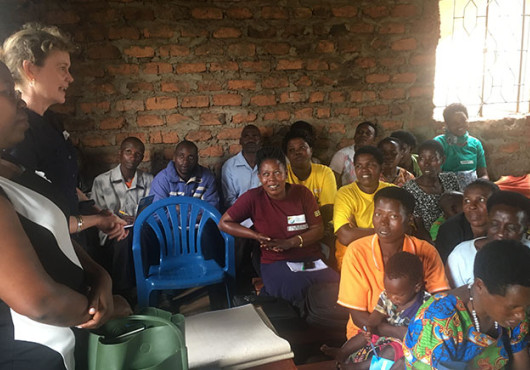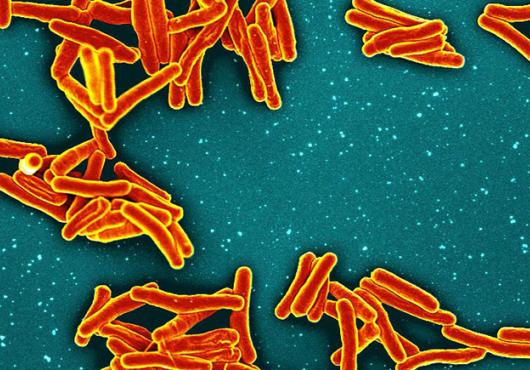
In science fiction, medics can wave a high-tech sensor at a patient and diagnose whatever ails them with a flash of light and a symphony of beeps and buzzes. Now, a new AI-enabled diagnostic tool is helping to make that space-age dream a reality on Earth.
The new tool, which facilitates postsurgical follow-up care at home for women recovering from caesarean sections in rural Rwanda, is the result of a multinational, multifaceted collaboration between researchers, clinicians, and community health workers from Harvard Medical School, MIT, Partners In Health, and Rwandan telemedicine tech firm Insightiv.
While more than 800 women around the world die each day from complications of pregnancy and childbirth, maternal mortality in Rwanda has fallen sharply in recent decades. One reason for the rapid decline in maternal deaths is improved access to comprehensive obstetric care, including an increase in surgical capacity, which allows greater access to C-sections for women in need.
Yet, the growing use of C-sections has been accompanied by an increase in postpartum surgical complications, such as infections of the surgical wound.
While Rwanda has a robust community health system that provides routine follow-up care for nonsurgical deliveries in new mothers’ homes, community health workers are not trained to provide post-cesarean care, so women who gave birth via C-section must travel to clinics and hospitals for their postpartum care.
The idea for a portable computer-aided diagnostic tool arose when the team’s early research showed that more than 10 percent of women giving birth in Rwanda develop postoperative surgical-site infection, with greatest risk for those who live further from a hospital, and that traveling to a clinic or hospital for routine surgical follow-up was physically and financially burdensome for many of these new mothers.
The latest version of the still-developing tool is a smartphone app that guides community health workers through general well-being assessments and includes an image-based surgical-site infection diagnostic guide based on a machine learning algorithm. The tool can render an accurate diagnosis nine out of 10 times, on average, a higher accuracy than that of trained diagnosticians reviewing the images remotely.
While an earlier version of the tool relied on an internet connection to access a remote server to perform the computer vision calculations, the latest edition of the tool is being designed to perform all the work locally, on the community health workers’ handheld smartphones, and is believed to be the first reported instance of onboard computer vision and machine learning for surgical wound analysis.
The project was named first-place winner of the National Institutes of Health Technology Accelerator Challenge for Maternal Health on July 28. The challenge was designed to spur and reward the development of prototypes of low-cost, point-of-care diagnostic tools for conditions associated with maternal and infant mortality and complications of pregnancy and childbirth, according to the NIH.
Bethany Hedt-Gauthier, associate professor of global health and social medicine in the Blavatnik Institute at HMS and the captain of the challenge project team, said that she and colleagues are planning to invest the $500,000 cash prize into further research and development of the project. Representatives from all of the winning teams discussed their work at a webinar on Aug. 4.
The other leaders of the team include Robert Riviello, HMS associate professor of surgery at Brigham and Women’s Hospital and associate professor of global health and social medicine, Adeline Boatin, HMS assistant professor of obstetrics, gynecology and reproductive biology at Massachusetts General Hospital, Laban Bikorimana, Vincent Cubaka, Fred Kateera, and Anne Niyigena from Partners In Health in Rwanda, Audace Nakeshimana from Insightiv AI, and Rich Fletcher, director of the Mobile Technology Group in the MIT Mechanical Engineering Department.
Identifying problems, developing solutions
“For me, global health work should be focused on solving specific problems defined in collaboration with the clinicians who are delivering care, the patients we are trying to care for, and the communities we seek to serve, with a focus on improving health equity,” said Hedt-Gauthier.
The team’s initial assessments of C-section outcomes in Rwanda included some surprising findings, such as high surgical-site infection rates. Several factors contribute to surgical-site infections, including access to safe sanitation, particularly during the dry season. A recent study found that most women who deliver via C-section in Rwanda return for follow-up care; however, the team’s research also found that more than 77 percent of women who needed to go to clinic for follow-up suffered catastrophic financial losses due to the cost of treatment, transportation, and lost work, even with Rwanda’s robust universal health insurance.
Engaging community health workers to support women during recovery could offer a safe and more preferred alternative. “We’ve learned so much from this project,” Riviello said. “One of the key lessons is how important it is to keep the big picture in mind. It’s not just the operating room that matters, it’s the whole hospital, the patient’s home life, the challenges of getting to and from the clinic and the hospital over great distances.”
Step by step
“Solving maternal health problems in an underserved community is an exceptionally complex challenge,” Boatin said. “You have to understand the clinical situation within its social context. When you add the additional level of complexity of training health care workers to provide a new service at the same time as you’re trying to build a new piece of technology, you need to bring together patients and clinicians, social scientists and technologists in a partnership where everyone’s voice can be heard.”
“Once you get the conversations started, you have to keep them going as you work toward a solution, step by step,” Boatin added.
In this case, that meant careful development, testing, and evaluation of a series of tools aimed at enabling community health workers to determine whether women who had C-sections needed to travel to the clinic for a possible infection or other problem. The buildup to the current tool started with a simple in-person or telephone questionnaire, then telemedicine enabled surgical-site analysis using cell phones to text images from the field to a diagnostician at a clinic or hospital, and eventually culminating in multiple versions of computer vision and machine learning tools.
“Before we began this work, gaps in postpartum care and their impact on outcomes for mothers who delivered by caesarean section were largely unknown,” said Fred Kateera, chief medical officer for Partners In Health in Rwanda and a lecturer at the University of Global Health Equity. “Fast forward just a few years, and we’re not only providing strong evidence for the feasibility of community-based use of technologies to provide follow-up care for new mothers in their own homes, we’re using data from this comprehensive suite of studies to inform local development of the CDC’s WASH programming, to improve our antibiotic stewardship, and to mitigate catastrophic expenditures for patients and their caregivers,” Kateera noted.
“We’re delighted to take a moment to celebrate the achievements, but we’re also excited to dig back in and see how much further we can go with this crucial implementation science,” he said.
The group is now working to incorporate computer vision diagnostics for anemia — another common complication of C-section — and exploring whether thermal imaging might be more accurate and more generalizable to other populations than color photography since thermal imaging is less reliant on skin tone, which can vary and can confound the computer vision algorithm.
Hedt-Gauthier said that she was excited that the work is being acknowledged and emphasized the importance of the multidisciplinary, multiperspective approach that the team took.
“Our team includes technologists, clinicians, researchers, and implementers,” Hedt-Gauthier said. “Working towards a solution that is both innovative and feasible, acceptable to patients and health care staff, and integrates within existing systems requires this varying expertise.”
Digital health has been alternately touted as a near-magical solution to global health problems or denigrated as yet another idea from privileged communities that instead of bringing greater equity can exacerbate existing disparities.
“The end goal of digital global health shouldn’t be to develop a cool tool that doesn’t work in low-resource settings, or to publish a paper in a journal for other researchers to read. It should be to help the people who need it most live healthier lives,” Hedt-Gauthier said. “The only way to get there is by working together, building deep collaborations, and keeping a relentless focus on the goals of health equity and solving problems for patients in need.”





